
Margaret Tudor was Queen of Scotland from 1503 until 1513 by marriage to King James IV. She then served as regent of Scotland during her son's minority, and fought to extend her regency. Margaret was the eldest daughter and second child of King Henry VII of England and Elizabeth of York, and the elder sister of King Henry VIII of England. By her line, the House of Stuart eventually acceded to the throne of England, in addition to Scotland.
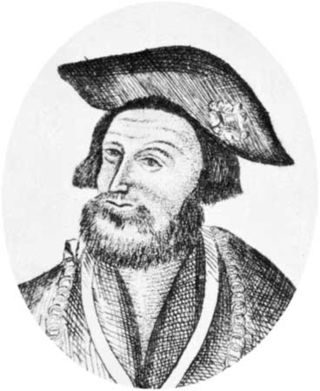
Sir David Lyndsay of the Mount was a Scottish knight, poet, and herald who gained the highest heraldic office of Lyon King of Arms. He remains a well regarded poet whose works reflect the spirit of the Renaissance, specifically as a makar.
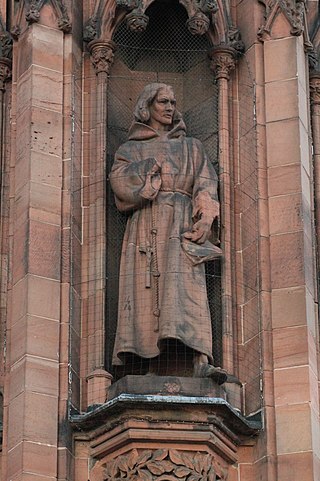
William Dunbar was a Scottish makar, or court poet, active in the late fifteenth and early sixteenth centuries. He was closely associated with the court of King James IV and produced a large body of work in Scots distinguished by its great variation in themes and literary styles. He was probably a native of East Lothian, as assumed from a satirical reference in The Flyting of Dumbar and Kennedie. His surname is also spelt Dumbar.

The ruins of Linlithgow Palace are located in the town of Linlithgow, West Lothian, Scotland, 15 miles (24 km) west of Edinburgh. The palace was one of the principal residences of the monarchs of Scotland in the 15th and 16th centuries. Although maintained after Scotland's monarchs left for England in 1603, the palace was little used, and was burned out in 1746. It is now a visitor attraction in the care of Historic Environment Scotland.

A Satire of the Three Estates, is a satirical morality play in Middle Scots, written by makar Sir David Lyndsay. The complete play was first performed outside in the playing field at Cupar, Fife in June 1552 during the Midsummer holiday, where the action took place under Castle Hill. It was subsequently performed in Edinburgh, also outdoors, in 1554. The full text was first printed in 1602 and extracts were copied into the Bannatyne Manuscript. The Satire is an attack on the Three Estates represented in the Parliament of Scotland – the clergy, lords and burgh representatives, symbolised by the characters Spiritualitie, Temporalitie and Merchant. The clergy come in for the strongest criticism. The work portrays the social tensions present at this pivotal moment in Scottish history.
John Tennent or Tennand of Listonshiels was a servant and companion of King James V of Scotland. He kept an account of the king's daily expenses which is an important source document for the Scottish royal court.
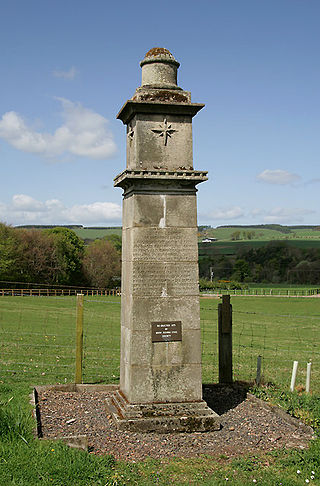
Antoine d'Arcy, sieur de la Bastie-sur-Meylan and of Lissieu, was a French nobleman involved in the government of Scotland.
William Stewart was a Scottish poet working in the first half of the 16th century.
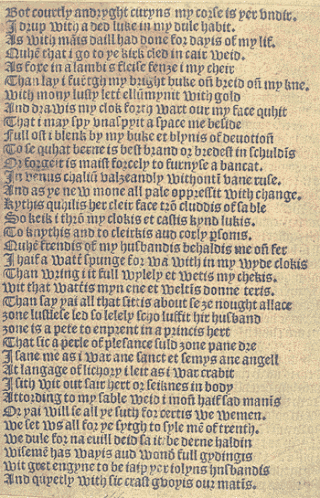
The Tua Mariit Wemen and the Wedo or The Tretis Of The Twa Mariit Wemen and the Wedo is a narrative poem in Scots by the makar William Dunbar.
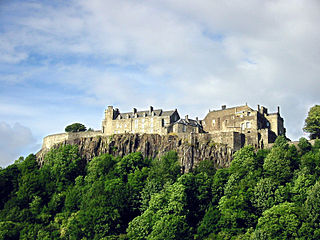
Ane Ballat of the Fenyeit Frier of Tungland, How He Fell in the Myre Fleand to Turkiland is a comic, satirical poem in Scots by William Dunbar composed in the early sixteenth century. The title may be rendered in modern English as A Ballad of The False Friar of Tongland, How He Fell in the Mire Flying to Turkey.

"Of Ane Blak-Moir" is a short poem in Scots by William Dunbar.

The Thrissil and the Rois is a Scots poem composed by William Dunbar to mark the wedding, in August 1503, of King James IV of Scotland to Princess Margaret Tudor of England.

The Petition Of The Gray Horse, Auld Dunbar is an appeal by the Scots poet William Dunbar to his patron King James IV of Scotland in which he requests a new gown to mark Christmas.
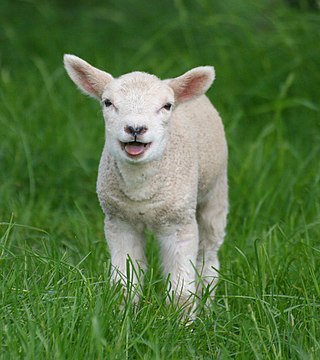
He Is Na Dog, He Is A Lam is a poem by William Dunbar addressed to Queen Margaret Tudor of Scotland.
Andrew Halyburton or Haliburton was a Scottish merchant.

Ellen or Elen More was an African servant at the Scottish royal court. She probably arrived in Scotland in the company of a Portuguese man with imported animals. There are records of clothing and gifts given to her, although her roles and status are unclear. Some recent scholarship suggests she was enslaved, and her arrival in Scotland can be linked indirectly with the slave trade. She is associated with a racist poem by William Dunbar, and may have performed in Edinburgh as the "Black Lady" at royal tournaments in 1507 and 1508.
William Foular was a Scottish apothecary who served the Scottish court.

Robert Spittell or Spittall or Spittale was a Scottish tailor who served Margaret Tudor, queen consort of James IV of Scotland.
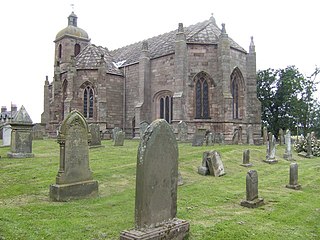
Thomas Peebles or Peblis was a Scottish glazier who worked for James IV, Margaret Tudor, and James V of Scotland.
Ane Dance in the Quenis Chalmer or A dance in the Queen's chamber is a humorous or satiric Scots poem by William Dunbar.















